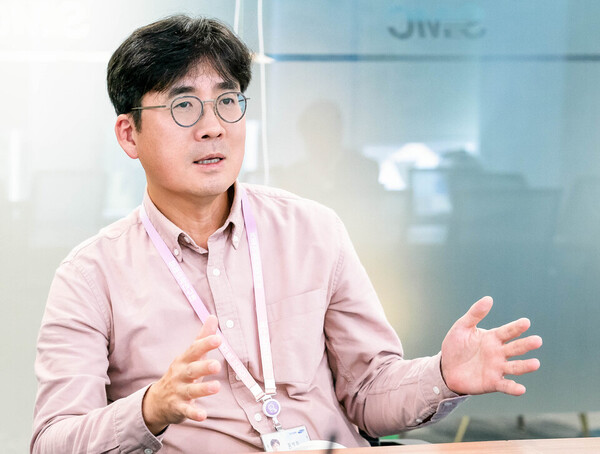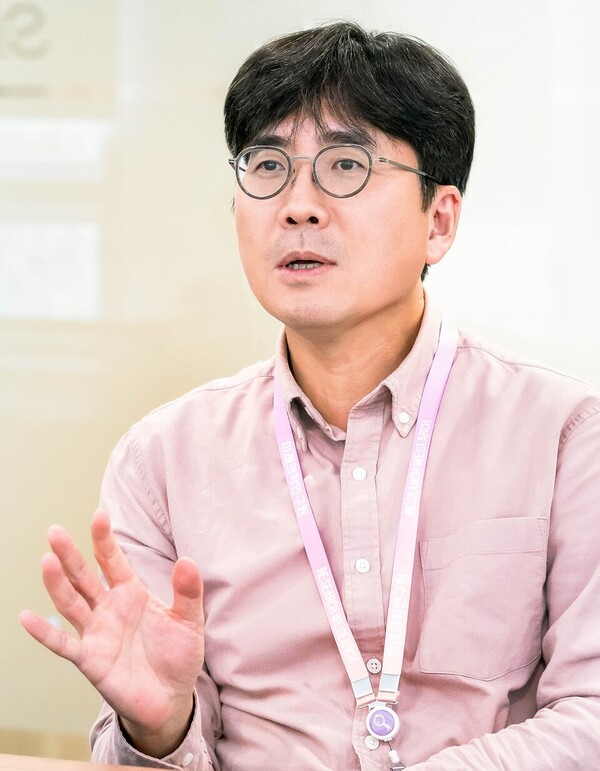Diffuse Large B Cell Lymphoma (DLBCL) is the most common and aggressive lymphoma subtype. For the past two decades, the standard for the first-line treatment of DLBCL has been the combination therapy known as "R-CHOP" (rituximab plus cyclophosphamide/doxorubicin/vincristine/prednisone).
Recently, however, Roche's antibody-drug conjugate (ADC) Polivy (polatuzumab vedotin) demonstrated a significant improvement in progression-free survival (PFS) combined with R-CHOP (rituximab plus cyclophosphamide plus doxorubicin plus prednisone) in the global phase 3 POLARIX study, introducing a new treatment option for the first-line treatment of DLBCL for the first time in 20 years.
In Korea, Roche received approval for Polyivy+R-CHP for the first-line treatment of DLBCL from the Ministry of Food and Drug Safety in November last year. In June this year, the company applied for reimbursement to the Health Insurance Review and Assessment Service (HIRA) and is awaiting a recommendation from the Cancer Disease Review Committee, the first gateway to reimbursement for anticancer drugs.
Meanwhile, the Korean Society of Hematology (KSH) has reportedly proposed to the government to allow Polivy+R-CHP to be used in high-risk patients with an International Prognostic Index (IPI) of 3 to 5, who are expected to have an insufficient response to the current standard therapy R-CHOP, given DLBCL's poor prognosis as it recurs.
Korea Biomedical Review spoke with Kim Seok-jin, professor of hematology-oncology at Samsung Medical Center and general affairs director at the KSH and chair of the Lymphoma Study Society, to learn about the latest treatment guidelines for DLBCL and the clinical role of Polivy + R-CHP therapy in the Korean treatment landscape.

Question: What kind of disease is DLBCL, and what is the current situation of patients in Korea?
Answer: Before discussing DLBCL, we need to know about lymphoma. Lymphoma is a tumor that develops in the lymphoid tissue of the body. Because lymphoid tissue is present throughout the body, it can occur in any organ, including skin and brain tissue. However, lymphoma is not a common cancer. There are about 6,000 to 7,000 new cases of lymphoma per year, about the same as pancreatic cancer (in terms of new cases). Neither is very common, but no one is unaware of pancreatic cancer. It's probably one of the most feared cancers. Lymphoma, on the other hand, is still less familiar. Lymphoma is divided into more than 70 subtypes, which can be further subdivided into more than 100 subtypes. This means there are many different subtypes with a small number of patients, each with different treatment directions and outcomes, and is not easy to understand.
Typically, lymphomas are categorized as Hodgkin or non-Hodgkin, non-Hodgkin as either B-cell or T-cell, and DLBCL is one of the many subtypes of B-cell lymphoma. When patients ask me, "What is my disease?" I explain that it's non-Hodgkin's, B-cell, and diffuse large B-cell lymphoma, like our hospital is in Ilwon-dong, Gangnam-gu, Seoul, the Republic of Korea.
There are many lymphoma subtypes; DLBCL accounts for the largest percentage, with 35-40 percent. If there are 6,000 new lymphoma cases, more than 2,500 are DLBCL. The cause of lymphoma is not yet understood except for a few subtypes. However, it is thought to be caused by an error in the process of the body's lymphoid tissue, which is constantly dividing, encountering foreign antigens, and increasing and dividing from birth to death.
Therefore, it is a disease that increases with age. With the recent increase in average age, the frequency of occurrence is expected to continue to increase. Twenty years ago, there were only 3,000 new patients, but now there are 6,000 to 7,000. The number of cases in Korea has been increasing yearly for the past 20 years, so it is a disease that cannot be overlooked, even if the absolute number is small.
Q: You said different lymphomas have different treatment directions and outcomes. What about DLBCL?
A: Just like there are gentle and aggressive people, so are lymphomas. In the case of indolent lymphoma, it is quite common to be diagnosed and observed for five to six years without any treatment. The problem is aggressive lymphomas that must be treated immediately, most notably DLBCL. Once diagnosed, DLBCL should be treated immediately, regardless of how small or large the lesion is or the stage.
Until the 1990s, there was no distinction between B-cell and T-cell lymphomas; all were treated with chemotherapy. When various combinations of anticancer drugs were used, we concluded that the traditionally used “CHOP therapy” was the best and has been used as a standard treatment.
However, in the early 2000s, an antibody called “rituximab” appeared, which attacks cancer by binding an antigen called “CD20” on the surface of B cells, and “R-CHOP therapy” combined with conventional CHOP became the standard worldwide. In Korea, this therapy has been covered by medical insurance since 2004.
In a phase 3 study, R-CHOP improved progression-free survival (PFS) by about 20 percent compared to conventional CHOP. Based on this, it became the standard treatment for DLBCL worldwide. Based on the five-year overall survival (OS) and five-year PFS of many studies over the past 20 years, 60-65 percent of all DLBCL patients can be cured with R-CHOP. However, about 40 percent of patients fail and relapse despite treatment with R-CHOP.
Furthermore, the 60 percent cure rate includes all patients with stages 1 through 4, so patients with stages 1 and 2 are much more likely to be included in that rate. In addition, some of the cured patients relapse after R-CHOP therapy and are cured with a stem cell transplant or other treatment.
Patients who relapse even once despite R-CHOP are more likely to relapse again and have a worse prognosis. Of course, the number of relapsed patients has increased with the advent of targeted therapies, immune checkpoint inhibitors, CAR-T therapies, and double-antibody therapies. Still, the most important thing is not to relapse. It is important for life and quality of life to live well for the rest of your life without relapse after the initial diagnosis. This is why Dr. Bertrand Coiffier, who first presented the R-CHOP therapy, said, "DLBCL requires optimal treatment at the time of diagnosis to ensure a cure, and we should not think about the following."
Q: What is currently lacking in DLBCL treatment in Korea?
A: As I said earlier, DLBCL should be treated effectively when first diagnosed, but the problem is Korea has been using only R-CHOP for 20 years. In the case of multiple myeloma, the second most common type of lymphoma, the first-line treatment is constantly changing and evolving with insurance coverage. However, they are still stuck in the R-CHOP regimen regarding lymphoma.
Many researchers have recognized the limitations of R-CHOP, and many global phase 3 studies still need to succeed. There are several possible explanations for this. For one thing, it could be a sign that R-CHOP is not as good as it seems. Another is that the trials included many less aggressive and stable patients who could have been treated with R-CHOP, making it difficult for the trial arms to show a difference. Also, managing side effects in lymphoma is as important as the drug's effectiveness, and it may not have been easy to address the side effects. If you have a complete response, but the complications are so severe that you die of an infection or something, your OS (overall survival) will be the same.
For all these reasons, there has been a lack of new proven treatment options beyond R-CHOP for the past 20 years, and the POLARIX study was the first to show an improvement in PFS with Polivy+R-CHP over R-CHOP. It is very encouraging that this was demonstrated in the challenging conditions I mentioned earlier. I'm often asked how meaningful the PFS benefit shown in the POLARIX study is for patients who are diagnosed and need to start treatment. In Korea, a significant number of patients are cured with R-CHOP therapy, so I believe that if we can provide more effective treatment from the beginning for "high-risk" patients at risk of failing R-CHOP rather than all patients, we can reduce the rate of relapse, which will help reduce socioeconomic costs.

Q: Regarding the Polivy+R-CHP reimbursement, we heard that your society has defined the reimbursement criteria as patients with an "IPI of 3-5". What are the clinical characteristics of these patients?
A: "IPI" is classified as a high-risk group when the score is 3 or higher in five items, including those over 60, those with declining health status (activity level), those with stage 3 or 4, those with invasion of two or more organs other than lymphoid tissue, and those with increased LDH (lactate dehydrogenase) level, which can confirm whether cancer cells are proliferating. A score of 4 or 5 is considered high risk, and an IPI score of 3 to 5 is an advanced stage. Age and health alone are only worth 2 points, so you can never be considered high risk if you only have the two.
In other words, our society's proposal of an IPI score of 3 to 5 means that it will selectively target benefits based on the cancer's aggressiveness and the tumor's extent. While the deliberations will depend on the outcome, it is clear that patients with high tumor burden and aggressive cancers will be reimbursed for what we have all tacitly acknowledged in the clinic as "under treatment with R-CHOP."
Q: We wonder if the toxicity will increase with the addition of Polivy.
A: The Polivy+R-CHP regimen adds Polivy to the existing R-CHOP regimen, minus the vincristine, which overlaps with the anticancer properties of Polivy. Technically, the number of anticancer drugs is the same. Instead of just administering vincristine, it's more like it's attached to an antibody so it can be delivered to target cells more effectively. If we were to use R-CHOP and add another agent with a different mechanism of action, it would be a six-drug regimen. However, I think that would be acceptable because it would be adding one agent to the regimen instead of subtracting one agent. In fact, in older, less active patients with stage 4, we still use a reduced dose of R-CHOP. In other words, we have to give less effective treatment. In such patients, antibody-drug conjugates (ADCs) are less toxic than cytotoxic antineoplastic agents. This is why Polivy is expected to reduce recurrence in patients with advanced stages who require effective treatment.

